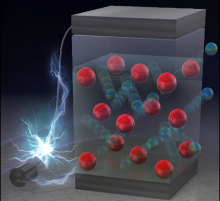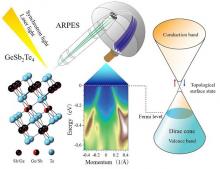Chemistry Electrochemistry
News
03 Apr 2024
Disease-causing E. coli among species labeled electrochemically using organic metallic nanohybrids
08 Jun 2023
Researchers at Kanazawa University report in ACS Nano how ultrathin layers of tin disulfide can be used to accelerate the chemical reduction of carbon dioxide — a finding that is highly relevant for our quest towards a carbon-neutral society.
20 Mar 2023
Researchers at Kanazawa University report in JACS Au how they have developed operando scanning ion conductance microscopy to allow simultaneous measurements of changes in the anode surface topography of a lithium ion battery during use, as well as the varying ion concentration with depth. Combining both types of information should help researchers evaluate the correlation between the two to design better batteries.
14 Dec 2022
- Time Energy Solution Co., Ltd. develops a general consumer-friendly hydrogen fuel generator (Eco-Friendly Hydrogen Fuel Cell Generator)
- Wins CES 2023 Award for Innovation in ‘Sustainability, Eco Design & Smart Energy’ with ‘Eco-friendly Hydrogen Fuel Cell Generator’
14 Dec 2022
- DGIST Professor Lee Hong-Kyung's joint research team develops convection-induced new concept electrolyte through magnetic nanoparticles, dramatically improving the lifespan of next-generation lithium metal batteries
- Recognized for its excellence, selected as the cover study in the prestigious international journal ‘Advanced Functional Materials’
27 Sep 2022
- The low-cost, high-energy, long-life lithium-sulfur battery is based on a novel silica/sulfur interlayer.
- The battery is expected to be used in next-generation mobile phones, drones, and electric vehicles owing to its high energy density and improved lifespan.
22 Jul 2022
Nonthermal plasma (NTP) is used to activate CO2 molecules for hydrogenation into alternative fuels at low temperatures, also enabling the conversion of renewable electricity to chemical energy. Researchers from Tokyo Tech combined experimental and computational methods to investigate the hydrogenation pathway of NTP-promoted CO2 on the surface of Pd2Ga/SiO2 catalysts. The mechanistic insights from their study can help improve the efficiency of catalytic hydrogenation of CO2 and allows the engineers to design new concept catalysts.
11 Jul 2022
A thermoelectric metal oxide film with a thermoelectric figure of merit of ~0.55 at 600°C has been discovered, opening new avenues towards the widespread use of thermoelectric converters.
22 Apr 2022
Scientists at Daegu Gyeongbuk Institute of Science and Technology (DGIST) in Korea have fabricated a flexible material that lights up brightly when stretched and/or when an electric field is applied. The results were published in the journal Applied Physics Reviews and show promise for the development of bright, sustainable, stretchable devices for use, for example, as interactive skin displays and in soft robotics.
25 Feb 2022
Scientists have developed a prototype sensor that could help doctors rapidly measure adenosine triphosphate (ATP) and lactate levels in blood samples from patients, aiding in the rapid assessment of the severity of some diseases.
17 Feb 2022
In a recent study published in the journal ACS Catalysis researchers from Kanazawa University describe novel scanning electrochemical cell microscopy measurements to determine sites of photoelectrochemical activity in titanium dioxide nanotubes.
28 Oct 2021
Researchers succeed in developing a lithium sulfide cathode containing a solid electrolyte with high decomposition resistance, enabling the realization of all-solid-state lithium-sulfur batteries that exceed the energy density of lithium-ion batteries
25 Oct 2021
Spontaneous wide-area spreading of oil on water inspires a facile energy-saving route of crafting electrically conductive nanostructures for future sensor/energy devices
01 Oct 2021
Researchers develop a composite film that can be used in nanogenerators to generate electricity from mechanical motion
24 Aug 2021
Researchers have succeeded in storing electricity with the voltage generated from ferromagnetic resonance (FMR) using a nanometer-thin magnetic film. Exploring the storage characteristics of the commonly used iron-cobalt and iron-nickel alloy thin films, they found that by controlling the thermal conditions of the thin film to be within FMR excitation range, energy can be stored by all the electromagnetic waves that surround us – including Wi-Fi.
13 Apr 2021
Scientists develop high performing electrocatalyst to synthesize ammonia in an effort to replace conventional eco-unfriendly methods
18 Feb 2021
Lithium ion batteries use liquid electrolytes that have several drawbacks, which can be overcome by all-solid-state lithium secondary batteries (ASSBs). However, it is important to find efficient electrode materials for ASSBs. A research team from Japan has recently developed a novel electrode material for ASSBs by combining lithium sulfate and lithium ruthenate, which results in improved performance. The scientists hope that their novel approach will guide future research and the eventual commercialization of such high-capacity batteries.
20 Nov 2020
A research team, affiliated with South Korea's Ulsan National Institute of Science and Technology (UNIST) has unveiled a new eco-friendly and low-cost method to synthesize indolopyran, one type of nitrogen ring compound, contained in about 60% of drugs that are recently approved by FDA.
10 Nov 2020
Scientists create a 3D digital “twin” of an all-solid-state battery to visualize its interfacial microstructures in detail
13 Oct 2020
The trick to extremely thin supercapacitors with improved performance is spraying graphene ink at an angle.
10 Aug 2020
Researchers have found electrons that behave as if they have no mass, called Dirac electrons, in a compound used in rewritable discs, such as CDs and DVDs. The discovery of “massless” electrons in this phase-change material could lead to faster electronic devices.
25 Jun 2020
Most common thin-film solar panels consist of expensive rare-earth elements like indium and gallium, or highly toxic metals like cadmium. Environment-friendly solar panels consisting of the abundant materials Cu, Zn, Sn offer attractive alternatives, but are hindered by their low practical efficiency compared to their theoretical potential. Researchers from DGIST have now discovered a way to overcome these hurdles.
10 Mar 2020
A recent study, affiliated with South Korea's Ulsan National Institute of Science and Technology (UNIST) has introduced a new composite catalyst that could efficiently enhance the charg-discharge performances when applied to metal-air batteries (MABs),
19 Sep 2019
DGIST Division of Energy Technology achieves the highest photoelectric conversion efficiency in the world. Huge expectations toward the commercialization of flexible solar cell that is applicable in various fields.
Events
Sorry, nothing coming up for this discipline
Researchers
Dr Naoka Nagamura is senior researcher at the National Institute for Materials Science (NIMS) and visiting associate professor at Tokyo University of Science. She researches advanced materials, electrochemistry and photoemission spectroscopy.
Ordered Functional Materials, like, COFs, COPs, CTFs for membrane applications (soft actuators and energy storage & conversion)
Giants in history
Sorry, nothing coming up for this discipline







![[Figure 1] Comparison of the lithium-sulfur battery incorporating the porous silica/sulfur interlayer developed here with a lithium-sulfur battery prepared using a conventional conductive interlayer or polar interlayer.](https://www.asiaresearchnews.com/sites/default/files/styles/medium/public/articles_images/3.%20Photographic%20data%20related%20to%20research%20results.png?itok=SVnYo7fI)

















